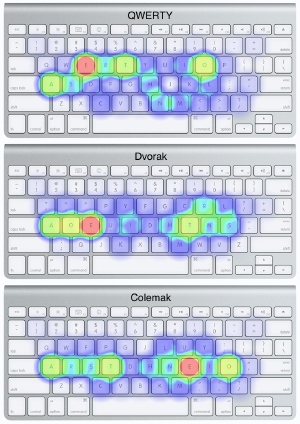Journal
QWERTY or Not QWERTY
2 August 2022
No matter what device you use, from a decades-old typewriter to a modern laptop, the keyboard layout is basically the same. Sure, things such as the arrow keys and control buttons might be different, but the letters and basic punctuation are always exactly where you expect them. It probably seems pretty normal now, but when you started it likely seemed odd that the keys weren’t in alphabetical order. And why aren’t the keys lined up? Why do they skew off to the left?
Part of this is due to the mechanical constraints of old typewriters, and part is due to the whims of history. We use qwerty because it’s popular. That’s the way Dad did it, that’s the way America does it, and it’s worked out pretty well so far. But there’s no reason why we can’t change.
 aimee rivers
aimee riversWhile it’s not true that the qwerty layout was designed to slow typists down and keep mechanical typewriters from jamming, it is a rather poor layout, particularly if you want to touch type. Ideally, the most common words should be either on or close to the home row where you hover your fingers. Of the top ten most popular letters (E, A, R, I, O, T, N, S, L, C, in that order) only three are on the home row. Five are on the upper row, and two are on the lower. Six of them are typed by the left hand, and only four by the right. So even touch typists find themselves bouncing their fingers all over the keyboard, which can get tiring.
Although I write blog posts directly at the keyboard, I do fiction writing by hand. It slows me down a bit and forces me to commit to what I write, so it works well for me. Until I have to type it all in. Typing up a hundred pages or more isn’t comfortable, and qwerty is part of the problem. But what can you do? Unless you want to go down the custom keyboard rabbit hole, the qwerty layout is all there is.
But if you have a modern Mac, Windows, or Linux machine, you aren’t limited to qwerty. Both Dvorak and Colemak layouts are built into the OS. Just go to your settings, and change it. Of course, then your keyboard letters don’t match what appears on the screen, and you have to learn a whole new way to type, which is a huge learning curve. But it isn’t as impossible as you might think. It takes practice, and there’s a period where your speed and accuracy in both qwerty and your alternative are terrible, but it gets better. And as long as you keep using qwerty from time to time you can switch between both rather easily.
Ghag ur, ar iykd ar jyl havf jylp rfggukdr pudhg, yghfpwurf jyl accusfkgaiij fks l; wpugukd nubbfpurh.1
That is, as long as you have your settings right, otherwise you accidentally end up writing jibberish. ↩︎